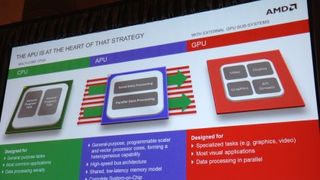The future of AMD: consoles, tablets and hybrids
How the fallen giant is changing its focus to new-gen tech
"We really believe [custom solutions are] a huge growth market for us in the future. Why is that? Because every OEM is looking for a way to differentiate. Using standard components it's hard to differentiate. The PlayStation 4 uses AMD's APU with eight Jaguar cores, over 1.8 TFLOPS of next-gen Radeon graphics - bringing together the PC ecosystem and the gaming ecosystem."

A key part of AMD's strategy is that APUs are the future. "This is something that's very clear," says Su. "We've been talking about the APU for a couple of years, but it's still very new and it's an important architecture, the bringing together of the CPU and GPU. This is our third generation, Llano, Trinity and now Richland. If you look at where the competition is going, they have taken some of our concepts, but our commitment to the integration of processor and graphics is number one in the industry."
Su is honest when she says not everyone shares AMD's optimism over consoles: "I would say that I love this business for a couple of reasons. First, high volume, over 100 million units - that's a very nice market. Second, it's absolutely playing into our sweet spot - we've said APUs are the centre of our universe.
"This is an application that's taken an APU architecture and tailored it for this application. A third point is that it really allows us to bring applications to a different level. Before we had developers developing for the PC ecosystem and the gaming ecosystem.
"They were architecturally different, so EA or any other developer had to split their resources over both ecosystems."
AMD says that by bringing those architectures closer together - although they're not the same, they are similar - it enables the company to develop the next generation of its Radeon graphics.
Lensing was obviously keen to promote AMD's now-released ultra-low power quad-core platform for tablets and small touchscreen Windows 8 laptops named Temash. The dual and quad-core chips are designed to slot in above Intel's Clover Trail Atom platform in performance terms. AMD is aiming them squarely at Windows 8 tablet and hybrid devices where they'll be branded as the AMD A4 and AMD A6.
Are you a pro? Subscribe to our newsletter
Sign up to the TechRadar Pro newsletter to get all the top news, opinion, features and guidance your business needs to succeed!

But AMD's problem, as ever, is getting manufacturers to take its hardware given the golden handcuff agreements many manufacturers have with Intel. Yet Lensing is bullish. "We've sold over 50 million [previous generation] Brazos chips. We're very confident we're going to be doing the same with Kabini. We took a product that people thought would compete with Atom, but we took it up against the low end of the mainstream market."
Growth segments
Su does sound a note that the old AMD hasn't gone away. "The PC business does have high-growth segments and [the market is] still shipping over 300 million units a year," she says.
"It's a good business, but it's facing some challenges. In graphics we have undiputed graphics leadership and it goes through all our [products] - it's very key for us to have that. We see a lot of growth in the server market and AMD is in a unique position to offer both x86 and ARM server form factors."
But Su is certain that AMD's reliance on traditional computing will decline. "Traditional computing is always going to be a part of AMD's business, but our technology can go further. And that's really where we're focusing on AMD over the next couple of years. Today more than 80% of our business is the PC business but by the end of 2013 embedded and semi-custom will be 20% of our business."
Dan (Twitter, Google+) is TechRadar's Former Deputy Editor and is now in charge at our sister site T3.com. Covering all things computing, internet and mobile he's a seasoned regular at major tech shows such as CES, IFA and Mobile World Congress. Dan has also been a tech expert for many outlets including BBC Radio 4, 5Live and the World Service, The Sun and ITV News.
